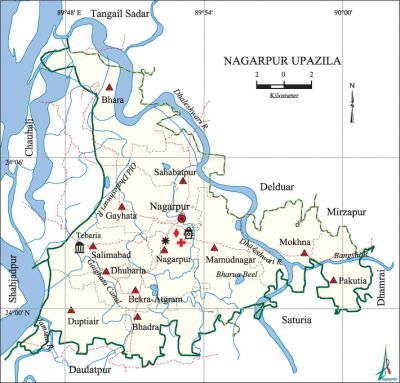Nagarpur Upazila
Nagarpur Upazila (tangail district) area 266.77 sq km, located in between 23°58' and 24°10' north latitudes and in between 89°46' and 90°01' east longitudes. It is bounded by tangail sadar and delduar upazilas on the north, daulatpur (manikganj) and saturia upazilas on the south, mirzapur and dhamrai upazilas on the east, chauhali and shahjadpur upazilas on the west.
Population Total 258431; male 126881, female 131550; Muslim 239115, Hindu 19295, Buddhist 8 and others 13.
Water bodies Main rivers: jamuna, dhaleshwari, Old Dhaleshwari, bangshi; Gaighata Canal and Bharua Beel are notable.
Administration Nagarpur Thana was formed in 1906 and it was turned into an upazila on 9 September 1983.
| Upazila | ||||||||
| Municipality | Union | Mouza | Village | Population | Density (per sq km) | Literacy rate (%) | ||
| Urban | Rural | Urban | Rural | |||||
|
- |
12 |
212 |
243 |
11477 |
246954 |
969 |
49.4 |
34.0 |
| Upazila Town | ||||||||
|
Area (sq km) |
Mouza |
Population |
Density (per sq km) |
Literacy rate (%) | ||||
|
4.68 |
3 |
11477 |
2452 |
49.4 | ||||
| Union | ||||
| Name of union and GO code | Area (acre) | Population | Literacy rate (%) | |
| Male | Female | |||
|
Gayhata 43 |
6346 |
12999 |
13391 |
37.53 |
|
Duptiair 21 |
6789 |
11792 |
11867 |
26.47 |
|
Dhubaria 36 |
3102 |
6022 |
6508 |
36.99 |
|
Nagarpur 73 |
5059 |
12356 |
12133 |
40.49 |
|
Pakutia 80 |
4069 |
9229 |
8755 |
35.16 |
|
Bekra-Atgram 10 |
1510 |
4987 |
5074 |
36.97 |
|
Bhadra 7 |
5404 |
10192 |
10573 |
34.51 |
|
Bhara 14 |
9204 |
12416 |
12442 |
30.58 |
|
Mamudnagar 58 |
8069 |
16780 |
17456 |
26.41 |
|
Mokhna 65 |
5891 |
9720 |
10691 |
33.75 |
|
Sahabatpur 87 |
5034 |
12556 |
13577 |
40.37 |
|
Salimabad |
5948 |
7832 |
9083 |
45.31 |
Source Bangladesh Population Census 2001, Bangladesh Bureau of Statistics.

Archaeological heritage and relics Tebaria Mosque (Mughal period), Building complex of Brindaban Chandra Bigraha.
History of the War of Liberation On 13 December 1971 the Pak army conducted heavy plundering and devastated the village Banagram of the upazila. On the same day the Pak army killed 7 members of the same family of village Sarengpur. Besides, the Pak army conducted heavy plundering at village Baranagar.
Marks of the War of Liberation Mass grave 1 (Sarengpur).
Religious institutions Mosque 279, temple 90. Noted religious institutions: Salimabad Mosque, Sudam Para Mosque and Gayhata Math.
Literacy rate and educational institutions Average literacy 34.7%; male 40.0%, female 29.7%. Educational institutions: college 3, secondary school 30, primary school 157, madrasa 123. Noted educational institutions: Nagarpur Government College (1966), Nagarpur Mohila College (1989), Gayhata Udaytara Multilateral High School (1879), Jadunath Pilot High School (1900), Afsar Memorial High School (1908), Pakutia BCRG High School (1916), Dhubaria Chhifatullah High School (1917), Sarengpur Bilateshwari High School (1921), Bhara Umesh Chandra High School (1930), Sahabatpur High School (1950), Nayan Khan Memorial High School (1989).
Newspapers and periodicals Weekly: Nagarpur Barta (irregular); irregular periodical: Dhaleshwari.
Cultural organisations Library 5, club 265, cinema hall 3, women cooperative society 13, playground 14.
Main sources of income Agriculture 61.63%, non-agricultural labourer 3.22%, industry 1.07%, commerce 11.20%, transport and communication 1.66%, service 10.50%, construction 0.74%, religious service 0.26%, rent and remittance 0.94% and others 8.78%.
Ownership of agricultural land Landowner 65.78%, landless 34.22%; agricultural landowner: urban 37.73% and rural 67.09%.
Main crops Paddy, jute, wheat, mustard, sugarcane.
Extinct or nearly extinct crops Sesame, linseed, kaun, sweet potato, china, kalai.
Main fruits Mango, jackfruit, banana, papaya, blackberry, plum.
Fisheries, dairies and poultries Dairy 71, poultry 40.
Communication facilities Pucca road 45 km, mud road 615 km; waterway 16.20 nautical miles.
Extinct or nearly extinct traditional transport Palanquin, bullock cart, horse carriage.
Cottage industries Goldsmith, blacksmith, potteries, wood work.
Hats, bazars and fairs Hats and bazars are 23, fairs 3, most noted of which are Nagarpur Hat, Salimabad Hat, Sahabatpur Hat, Dhuni Para Hat and Chaitra Samkranti Mela at Duajani.
Main exports Paddy, jute, banana, sugarcane.
Access to electricity All the unions of the upazila are under rural electrification net-work. However 9.09% of the dwelling households have access to electricity.
Sources of drinking water Tube-well 92.97%, pond 0.22%, tap 0.36% and others 6.45%.
Sanitation 22.61% (rural 20.85% and urban 60.20%) of dwelling households of the upazila use sanitary latrines and 72.31% (rural 74.14% and urban 33.29%) of dwelling households use non-sanitary latrines;' 5.08% of households do not have latrine facilities.
Health centres Upazila health centre 1, satellite clinic 6, family planning centre 12, community clinic 35, private clinic 6.
NGO activities Operationally important NGOs are proshika, asa, brac. [Md Moniruzzaman]
References Bangladesh Population Census 2001, Bangladesh Bureau of Statistics; Cultural survey report of Nagarpur Upazila 2007.
